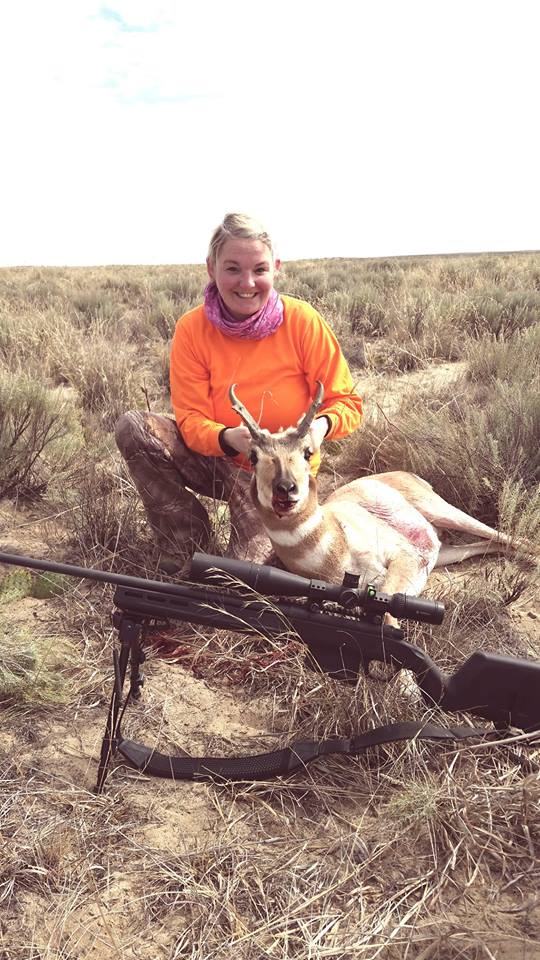
After years of hunting doe and getting my first cow elk down last year, I was excited to get the opportunity to hunt pronghorn this fall. As with any hunt, I don’t assume that I know what I’m doing outside of being able to handle my gun and use my wits to have a successful hunt; instead, I research the animal’s habits, what to expect from the hunt, and the layout of the land. I had 2 weeks to prepare, so I spent my time reading other successful pronghorn hunts in Colorado and felt comfortable to start my hunt early in the morning to take a pronghorn buck down. Little did I know, I would be the first one out of six hunters – all of which were male, except for me – to take a pronghorn down.
Pronghorn? Antelope? Pronghorn Antelope?
Never really looking into what the name of the animal was and why so many people use different names, I was calling my hunt an antelope hunt. However, the correct word is pronghorn. Pronghorns get their name from the horns they have on their head. That’s right, they’re not antlers like deer and elk have; in fact, when you boil a head down for a European mount, you can see the white horns protruding from their skull under the brown sheath that covers them. Pronghorns are only found in North America. Its Latin name is Antilocapra americana, which translates to “American goat-antelope;” yet, it is not in the goat or antelope family. Pronghorns are the last remaining species of their kind.
Other names for pronghorn are speed goat, prairie ghost, sage goat, desert racer, sagebrush rocket, and goat-a-lope. Indeed, these animals are fast, live on the prairie, and are often confused with goats and antelopes, but they hold their own in the animal kingdom.
Let’s Talk Speed. Let’s Talk the Fastest Animal on the Planet.
Before we even thought about pronghorn hunting, my youngest son said, “Mom, do you know what the fastest animal on the planet is?” I said, “No, what is it?” He said, “A pronghorn.” I said, “No way, cheetahs have to be faster. Perhaps, an ostrich too?” So, we looked it up, and guess what, the pronghorn is the second fastest animal on the planet – the cheetah being number one – but a pronghorn can beat the cheetah in endurance by keeping its speed longer; so yes, when it comes to endurance, the pronghorn is the fastest animal on the planet with speeds up to 57mph… and I’m about to hunt it.
How the heck am I going to hunt the fastest animal on the planet, on a flat prairie with nowhere to hide, that is also filled with cacti?
Hunting Pronghorn in Colorado with Lots of Cacti.
In my research, I learned that it’s best to stay low to the ground and blend in with rolling hills, if possible. I also learned that when you’re low to the ground in cacti country, you should have layers on – or even elbow and knee pads to protect yourself while crawling low to the ground. Well, I didn’t read that part until we were almost to camp. Crap. Perhaps, there won’t be cacti, right?
Wrong. Even with six layers of shirts on, two layers of pants, and being cautious of the cacti everywhere, I still got cacti needles in me – everywhere. I was picking out cacti needles days after my hunt was over – and they sting. We have no idea where we picked up so many cacti needles, but they were everywhere.
Beyond the cacti needles, the hunt was successful. We set out early in the morning before the sun even rose. The land looked pretty flat, but we started to notice there were rolling hills, just small ones. We hiked in about 2 miles and found a spot that we thought we could easily blend in with the land. In our time sitting, we glassed the prairie and saw small herds of bucks and does as they grazed or trotted by, but none close enough to take a shot at that we were comfortable with.
Just before noon, we heard a gunshot in the distance, which is a sign to watch for wildlife running. We started glassing the countryside again, and within – what felt like – seconds, a buck pronghorn ran up about 200 yards from us. He stopped and looked in our direction, ran another 10 feet and stopped again. I took my shot as my husband watched him with his binoculars. The pronghorn turned to run away and I felt the feeling of disappointment as I watched him disappear over the hillside. That is, until my husband shouted, “You got him! He just went down!” I started shaking with excitement as we gathered our gear and sent out to find the buck.
It took us about 10 minutes of looking and me praying that we find him with a clean shot through before we stumbled upon him. Double-lung shot – it was perfect.

Bucks vs Does
The does can grow horns too, so you can’t judge the difference between a male and female based on horns alone. Bucks have black cheeks and a black face that help hunters tell the difference between the sexes. The bucks have longer horns, and in the state of Colorado must be longer than 5” to be legal.
Pronghorn Vision
Pronghorns have the largest eyes of any North American land animal, which gives them a 300-degree arc of vision without it even moving its head… try hiding from that. In addition to having amazing vision, they also have a keen sense of smell and hearing.
Pronghorn Warnings
Pronghorns give warnings to each other by lifting their rump hair to make it reflective to the rest of the herd. This reflection can be seen up to two miles away, and tells the herd to run, which they’ll all do together. This is why hunting a single pronghorn is better than a herd.
Pronghorn Flagging
Even with as quick as pronghorns are, they are curious creatures, which a big advantage for your hunt. By simply tieing a flag, scarf, or plastic bag to the end of your gun and leaving it to wave in the wind, you could easily draw in the interest of a pronghorn. I’ve heard of local hunters tying a plastic bag to their antenna and getting the attention of a buck and tying a pink ribbon to a tree branch and calling in a herd. As of writing this, pronghorn flagging is legal in Colorado but check with your local regulations to verify.

Eating Pronghorn
Anytime I talk about eating wild game (outside of my hunting mates, of course), I always get, “Well, how do you eat that?” Especially when it comes to big game like pronghorn and bear. I grew up eating odd foods like squirrel, raccoon, alligator, and snake so I’m okay trying new foods; in fact, I love it. When someone tells me that they’ll NEVER eat deer because it tastes horrible compared to elk, I tell them, “That’s probably because you don’t know how to field dress it, prep it, or cook it.” If you take your time with ensuring the meat is treated properly from the moment it goes down, to the moment it goes into the freezer, to the moment it goes in your mouth, any of these meats can be good eatin’.
How does pronghorn taste? Just like any other meat mentioned above. Well, maybe not alligator or snake. Pronghorn can be cooked just like you would elk or deer. It can be cooked as a stand-alone steak, in a stew or chili, or ground up to make meatloaf. Below, I’ll share my pronghorn backstrap recipe with you – this girl knows how to cook a steak, I’m tellin’ ya.
Pronghorn Backstrap
The backstrap is often confused with tenderloins or inners; where in fact, backstraps are on the back of the animal and run alongside the spine. Inners (or tenderloins) run alongside the underside of the spine. Both are incredibly tender and tasty, but for some reason, hunters often forget about the inners – that’s a no-no in this hunting family.
Whether you’re eating the backstrap or the inners, overcooking these savory pieces can lead to disappointment that lasts the span of time. Make sure to have a thermometer in hand and cook to temperature instead of sight. I’ve been cooking my steak recipe for so long that I can basically eyeball it now, but with my wild game, I still use a thermometer. I also swear that all you need is a good cast iron pan, butter, salt, and pepper. Throw in some herbs if you want, but keep it simple.

Pronghorn Backstrap Recipe
Ingredients
- 1 Backstrap
- Salt and Pepper To Taste
- Butter
Instructions
- Trim off any fat or silverskin that may be left on.
- Cut the backstrap to fit the size of your pan. I use a 10 inch cast iron pan and had to cut the pronghorn backstrap in half so that it fit the pan. This is assuming your backstrap is whole and not pre-cut into steaks.
- Season the backstrap with salt and pepper.
- Turn on your oven to 350℉.
- Get the oven-safe pan scorching hot – as hot as your stovetop can get it.
- Throw in a pad or two of butter and watch it sizzle.
- Add the backstrap and sear it on each side for a couple of minutes or until you see a good sear. If you’re adding herbs, like rosemary, add it to the pan at this time, as well, and let it cook in the butter.
- Once seared, put the pan and backstrap in the oven until the backstrap reaches 125℉ for medium-rare.
- Pull backstrap out of the oven and let rest, tented under foil, for 10 minutes.
- Slice and serve.




This was fantastic! I used it for pronghorn tenderloin. Delicious. Added garlic powder instead if rosemary and it was melt in your mouth delicious.
What great content. Saved and shared. Now all I need is to draw a private land doe tag next month.
Filled my tag this morning!!
Definitely trying this recipe this weekend!!
a562cn